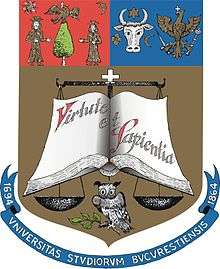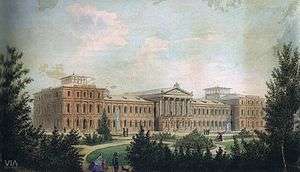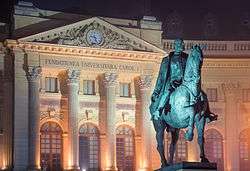University of Bucharest
| Universitatea din București | |
 Emblem of the University | |
| Motto | Virtute et sapientia (Latin: "By virtue and wisdom") |
|---|---|
| Type | Public |
| Established | 1864 |
| Rector | Mircea Dumitru |
Academic staff | 1,279 |
| Students | 31,805 (2012-2013)[1] |
| Undergraduates | 21,772 |
| Postgraduates | 10,033 |
| Location | Bucharest, Romania |
| Colors | Red and Blue |
| Website | http://www.unibuc.ro |
The University of Bucharest (Romanian: Universitatea din București), commonly known after its abbreviation UB in Romania, is a public university founded in 1864 by decree of Prince Alexandru Ioan Cuza to convert the former Saint Sava Academy into the current University of Bucharest, making it the second oldest modern university in Romania. The University of Bucharest offers study programmes in Romanian and English and is classified as an advanced research and education university by the Ministry of Education. In the 2012 QS World University Rankings, it was included in the top 700 universities of the world, together with three other Romanian universities.[2]
History
In 1694 Constantin Brâncoveanu, ruler of Wallachia, had founded the Princely Academy of Saint Sava in Bucharest with lectures delivered in Greek. In 1776, Alexander Ypsilantis, ruler of Wallachia, reformed the curriculum of the Saint Sava Academy, where courses of French, Italian and Latin were now taught. In 1859, the Faculty of Law was created. In 1857, Carol Davila created the Carol Davila University of Medicine and Pharmacy. In 1857, the foundation stone of the University Palace in Bucharest was laid.

On July 4/16 1864 Prince Alexander John Cuza created the University of Bucharest, bringing together the Faculties of Law, Sciences and Letters as one single body. In the following years, new faculties were created: 1884 – the Faculty of Theology; 1906 – the Institute of Geology; 1913 – the Academic Institute for Electrotechnology; 1921 – the Faculty of Veterinary Medicine; 1923 – the Faculty of Pharmacy, 1924 – the Mina Minovici Institute of Forensic Medicine.
In 1956, student leaders, mainly from this university, planned a peaceful protest against Romania's Communist regime but were forcibly prevented from carrying it out. (See Bucharest student movement of 1956)
For a while (1950s-early 1960s?), it was called the "C. I. Parhon University", after C. I. Parhon.
Post-1989 history
The area around the old University building (the University Square), adjacent to the C. A. Rosetti, Roman, Kogălniceanu, and Union Squares was the scene of many riots, protests and clashes with the security forces during the Romanian Revolution of 1989. During the months of April–June 1990, the University of Bucharest was the centre of anti-communist protests.
In 1996, Emil Constantinescu, the then rector of the University of Bucharest, was elected President of Romania, after defeating Ion Iliescu in national presidential elections.
Ranking
In the 2012 QS World University Rankings University of Bucharest was included in the Top 601 + 701 universities of the world, together with three other Romanian universities, including Babeș-Bolyai University in Cluj-Napoca, and Alexandru Ioan Cuza University in Iași[3][4]
Faculties
The University of Bucharest has 19 faculties, covering fields such as natural sciences, humanities, social sciences, and theology:
- Faculty of Administration and Business
- Faculty of Biology
- Faculty of Chemistry
- Faculty of Foreign Languages and Literatures
- Faculty of Geography
- Faculty of Geology and Geophysics
- Faculty of History
- Faculty of Journalism and Communication Studies
- Faculty of Law
- Faculty of Letters
- Faculty of Mathematics and Computer Science
- Faculty of Philosophy
- Faculty of Physics
- Faculty of Political Science
- Faculty of Psychology and Educational Studies
- Faculty of Sociology and Social Work
- Faculty of Baptist Theology
- Faculty of Orthodox Theology
- Faculty of Roman Catholic Theology and Social Work

The University also has a publishing house, different research institutes and research groups (such as the Institute for Political Research, the Institute for Mathematics, the Center for Byzantine Studies, the Vasile Pârvan Archeology Seminary, the Center for Nuclear Research, etc.), master and doctorate programmes, and a number of lifelong learning facilities and programmes. It has partnership agreements with over 50 universities in 40 countries, and participates in European programmes such as ERASMUS, Lingua, Naric, Leonardo da Vinci, UNICA, AMOS, TEMPUS, TEMPRA. It is an accredited Cisco Academy, has Microsoft curriculum, and is accredited by Red Hat for its academic programme.
The University of Bucharest has been awarded the 2000 National Academic Excellence Diploma, and the 2004 National Academic Excellence Medal. All of the degrees and diplomas awarded by the university are internationally recognised.
International Programs
The University of Bucharest is a member of international organisations including: - The Association of Universities in European Capitals (UNICA) - The Network of South-East European Universities - The European University Association (EUA) - Agence Universitaire de la Francophonie (AUF) - Black Sea Universities Network (BSUN) - Academic Cooperation Association (ACA) - European Inter-University Centre for Human Rights and Democratization (EIUC) - Eurasian Universities Union (EURAS) - SEE GRID - South-East Europe GRID - 2005 - Central European Exchange Program for University Studies (CEEPUS) - ERASMUS NETWORK EUE-NET - Educational Structutre in Europe, Phase IV (TUNING) - European Physics Education Network (EUPEN) - Stakeholders Tune European Physics Studies (STEPS)
As part of on-going ERASMUS programme, the University of Bucharest has approximately 225 Erasmus agreements with European partner universities.
Facilities
Buildings
The University of Bucharest has a number of buildings throughout Bucharest, so in that respect it does not have a single campus. Its two main buildings are:
- The Old Building, in the University Square (practically right in the center of the city), housing the Faculties of Mathematics and Computer Science, History, Chemistry, Geography, Letters and the Department of Romance Languages and Literatures.
- The Kogălniceanu Building, near the Opera House, housing the Administrative section and the Faculty of Law.
Other faculties have their own buildings and research facilities, scattered throughout the city, such as:
- The Departments of Germanic, Slavic and Oriental Languages and Literatures, on Pitar Moş Street.
- The Faculty of Physics, in the small town of Măgurele, situated 16 km (9.9 mi) south of Bucharest.
- The Faculty of Political Science, on Sfântu Ştefan Street.
- The Faculty of Orthodox Theology, in the Unirii Square
- The Faculty of Medicine Carol Davila in Eroilor Sanitari
The University prints a yearly guide for freshmen.
Faculty, alumni and rectors
-
- Eugène Ionesco Romanian-French playwright widely considered as the most important of the 20th century
- Ion Barbu, also known as Dan Barbilian - mathematician and poet;
- Silviu Brucan - political analyst and author
- George Călinescu - writer and literary critic
- Mircea Cărtărescu - Postmodern writer
- Emil Constantinescu - former President of Romania
- Petru Creţia - philologist
- Neagu Djuvara - historian
- Alexandru Graur - linguist
- Aristide Halanay - mathematician, disciple of Viktor Vladimirovich Nemytskii
- Spiru Haret - mathematician, astronomer and politician
- Iorgu Iordan - linguist
- Nicolae Iorga - historian, literary critic and politician
- Traian Lalescu - mathematician
- Gabriel Liiceanu - philosopher
- Titu Maiorescu - literary critic
- Nicolae Manolescu-literary critic
- Solomon Marcus - mathematician
- Adrian Năstase - politician
- Miron Nicolescu - mathematician
- Bogdan Petriceicu Hasdeu - writer and philologist
- Dimitrie Pompeiu - mathematician
- Alexandru Rosetti - linguist
- Ion Th. Simionescu
- Simion Stoilow - mathematician
- Nicolae Titulescu - politician
- Tudor Vianu - literary critic, philosopher
- Dan-Virgil Voiculescu - mathematician
- Gheorghe Vrânceanu - mathematician
-
- Albert-László Barabási - physicist
- Gheorghe I. Cantacuzino - archeologist
- Zoia Ceauşescu - mathematician, daughter of Nicolae Ceauşescu
- Elena Ceauşescu - research chemist, Deputy Prime Minister (1980-1989), wife of Nicolae Ceauşescu
- George Ciucu - mathematician
- Iosif Constantin Drăgan - businessman, writer and historian
- Paul Timitriu - polititician and publicist
- Mircea Eliade - historian of religion, fiction writer, philosopher, and professor at the University of Chicago
- Mircea Cărtărescu - postmodern writer
- Nicholas Georgescu-Roegen - economist
- Eugen Filotti - diplomat
- Horia Hulubei - physicist
- Traian Lalescu - mathematician
- Gheorghe Mihoc - mathematician
- Grigore Moisil - mathematician and computer scientist
- Miron Nicolescu - mathematician
- Grigore Iunian - politician
- Ştefan Odobleja - scientist, one of the precursors of cybernetics
- Octav Onicescu - mathematician
- George Emil Palade - cell biologist, 1974 Nobel Prize laureate
- Nicolae Paulescu - Romanian physiologist, professor of medicine, missed the Nobel Prize 1923 for discovering insulin
- Eleni Papadopulos-Eleopulos - Nuclear Physicist and AIDS denialists
- Andrei Pleşu - philosopher, essayist, journalist, literary and art critic, and politician
- Dorin N Poenaru - Nuclear Physicist
- Valentin Poénaru - mathematician
- Victor Ponta - Romanian Prime-Minister[5]
- Constantin Rădulescu-Motru - psychologist and sociologist
- Mircea Rusu - physicist
- Irina M. Russu - biophysicist
- Mihail Sadoveanu - writer
- E.M. Cioran - essayst
- Gheorghe Taşcă - economist
- Șerban Țițeica - physicist
- Radu Vasile - politician and poet
- Dan-Virgil Voiculescu - mathematician
- Gheorghe Costaforu (1864-1871)
- Vasile Boerescu (1871)
- Ioan Zalomit (1871-1885)
- Alexandru Orăscu (1885-1892)
- Titu Maiorescu (1892-1897)
- Grigoriu Ștefănescu (1897-1898)
- Constantin Dimitrescu-Iași (1898-1911)
- Ermil Pangrati (1911-1912)
- Ioan Bogdan (1912)
- Thoma Ionescu (1912-1915)
- Ioan Athanasiu (1915-1920)
- Mihail Vlădescu (1920-1923)
- Ermil Pangrati (1923-1929)
- Nicolae Iorga (1929-1932)
- Nicolae Gheorghiu (1932-1936)
- Constantin C. Stoicescu (1936-1940)
- Petre P. Panaitescu (1940-1941)
- Alexandru Otetelișanu (1941)
- Horia Hulubei (1941-1944)
- Daniel Danielopolu (1944)
- Simion Stoilow (1944-1946)
- Alexandru Rosetti (1946-1949)
- Ilie G. Murgulescu (1949-1950)
- Constantin Balmuș (1950-1952)
- Avram Bunaciu (1952-1954)
- Nicolae Sălăgeanu (1954-1957)
- Iorgu Iordan (1957-1958)
- Jean Livescu (1959-1963)
- Gheorghe Mihoc (1963-1968)
- Jean Livescu (1968-1972)
- George Ciucu (1972-1981)
- Ioan-Ioviț Popescu (1981-1988)
- Ion Dodu Bălan (1989)
- Nicolaie D. Cristescu (1990-1992)
- Emil Constantinescu (1992-1996)
- Ioan Mihăilescu (1996-2005)
- Ioan Pânzaru (2005-2012)
- Mircea Dumitru (2012-)
See also
References
- ↑ Culture and Discovery
- ↑ Institutii de invatamant superior clasificate ca universitati de cercetare avansata si educatie
- ↑ "University of Bucharest". topuniversities.com. 7 December 2012.
- ↑ "Cele mai bune universităţi din lume. Patru universităţi româneşti sunt printre primele 700" (in Romanian). Adevarul. 11 September 2012.
- ↑ Found guilty by the Commission of Ethics of this university of plagiarizing his PhD thesis in law, see Quirin Schiermeier Conflicting verdicts on Romanian prime minister's plagiarism. Victor Ponta cleared of misconduct by government ethics board, but charges reaffirmed by university. Nature, 20 July 2012.
External links
| Wikimedia Commons has media related to University of Bucharest. |
- (English) Official site
Coordinates: 44°26′8.00″N 26°6′4.02″E / 44.4355556°N 26.1011167°E